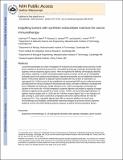Engulfing tumors with synthetic extracellular matrices for cancer
Author(s)
Hori, Yuki; Stern, Patrick; Hynes, Richard O; Irvine, Darrell J
DownloadHynes_Engulfing tumors.pdf (2.118Mb)
OPEN_ACCESS_POLICY
Open Access Policy
Creative Commons Attribution-Noncommercial-Share Alike
Terms of use
Metadata
Show full item recordAbstract
Local immunotherapies are under investigation for the treatment of unresectable tumors and sites of solid tumor resection to prevent local recurrence. Successful local therapy could also theoretically elicit systemic immune responses against cancer. Here we explored the delivery of therapeutic dendritic cells (DCs), cytokines, or other immunostimulatory factors to tumors via the use of ‘self-gelling’ hydrogels based on the polysaccharide alginate, injected peritumorally around established melanoma lesions. Peritumoral injection of alginate matrices loaded with DCs and/or an interleukin-15 superagonist (IL-15SA) around 14-day established ova-expressing B16F0 murine melanoma tumors promoted immune cell accumulation in the peritumoral matrix, and matrix infiltration correlated with tumor infiltration by leukocytes. Single injections of IL-15SA-carrying gels concentrated the cytokine in the tumor site ∼40-fold compared to systemic injection and enabled a majority of treated animals to suppress tumor growth for a week or more. Further, we found that single injections of alginate matrices loaded with IL-15SA and the Toll-like receptor ligand CpG or two injections of gels carrying IL-15SA alone could elicit comparable anti-tumor activity without the need for exogenous DCs. Thus, injectable alginate gels offer an attractive platform for local tumor immunotherapy, and facilitate combinatorial treatments designed to promote immune responses locally at a tumor site while limiting systemic exposure to potent immunomodulatory factors.
Description
available in PMC 2010 June 1.
Date issued
2009-12Department
Massachusetts Institute of Technology. Department of Biological Engineering; Massachusetts Institute of Technology. Department of Biology; Massachusetts Institute of Technology. Department of Materials Science and Engineering; Koch Institute for Integrative Cancer Research at MITJournal
Biomaterials
Publisher
Elsevier B.V.
Citation
Hori, Yuki et al. “Engulfing Tumors with Synthetic Extracellular Matrices for Cancer Immunotherapy.” Biomaterials 30.35 (2009): 6757–6767. Web.
Version: Author's final manuscript
ISSN
0142-9612
1878-5905